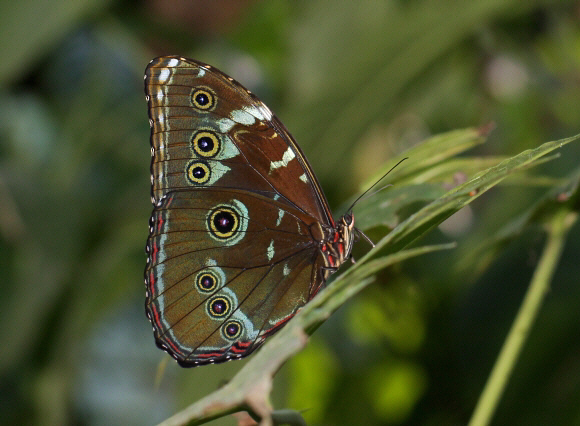
Introduction
It is a source of amusement to lepidopterists that the general public in Latin America always refer to every one of the Morpho species as if they were just one creature – “the Blue Morpho”. There are in fact at least 29 described species, possibly more, as the status of some subspecies is contended by certain taxonomists who consider they should be elevated to the rank of full species.
The dazzling blue wings of Morpho butterflies are enormous relative to their body size, resulting in a very distinctive slow, bouncy flight pattern. The effect is that the brilliant blue upperside appears to flash like a beacon as it alternates in flight with the dark undersurface. This makes it difficult for a bird to follow the flight. If attacked when on the wing, the slow lazy flight pattern instantly changes into a wild swooping evasive manoeuvre, following which the butterfly dives into the forest where it instantly settles. A pursuing bird is still of course searching for a brilliant blue insect, but the Morpho snaps its wings shut, displaying the dark brown underside and foiling the bird’s search program. If the bird does manage to spot the settled butterfly it invariably aims its attack at the most prominent feature – in this case the ocelli, missing the body entirely and allowing the butterfly to escape.
Andrew Neild (author of Butterflies of Venezuela) describes the differences between helenor and achilles thus: “In helenor the submarginal whitish band on the underside hindwing widens towards the apex and is usually widest at the apex; in achilles it narrows towards the apex, and is usually wider / widest in its mid section. Also, but not always, on the FW, in space 3 (the one that usually has the biggest FW ocellus), the broad pale band is almost always crescent-shaped. In achilles it is usually triangular, or if nearly crescent-shaped, wider than it is in sympatric helenor.”
Morpho achilles is a widespread species found from Colombia, Venezuela and Guyana, south along the astern Andes to Peru and Bolivia. There are 8 named subspecies.
Habitats
This species is restricted to rainforest habitats at altitudes between 0-1000m.
Lifecycle
I have no data specific to achilles. The eggs of most other Morpho species are dome-shaped and pale green with a narrow reddish ring near the top. Most Morphos lay apparently their eggs singly but several Morpho species have gregarious larvae, strongly suggesting that their eggs are laid in clusters. Fully grown larvae are plump, with a large head. Their bodies are beautifully patterned with fine longitudinal lines of bright red, yellow and black, and covered with fine brown hairs which are tufted near the head and tail, and in the middle of the back. Morpho larvae feed on the leaves of a wide range of trees in the family Fabaceae including Macharium, Pterocarpus, Lonchocarpus, Swartzia and Dalbergia. The larvae have eversible glands on the thorax which emit a strong odour as a defence against predators. The pupae are pale green and bulbous, and are suspended from a stem or leaf of the foodplant.
Adult behaviour
Males of achilles patrol back and forth along rivers and streams, searching for females. They are most active in the mornings, and spend most of the afternoon visiting sap runs, feeding at rotting fruit or sitting motionless on foliage in the darkness of the forest. Females, which are recognizable by the wider dark borders on the uppersides, are seen far less frequently.
Both sexes close their wings immediately upon landing, but periodically flick them open to give the briefest glimpse of the dazzling blue upperside. This behaviour is most pronounced in mud-puddling males, which repeatedly flicker their wings as they hop about on the ground seeking dissolved minerals.
